Part 4: Dances of the Balkans
11 Dances of the Western Balkans
1. What and Where are the Balkans?
The Balkan countries (not to be confused with the Baltic countries!), sit in the southeast corner of Europe and into Asia Minor. Traditionally speaking the Balkans were the nations that formed the “Balkan Peninsula”, which is essentially the chunk of land that lies between the Adriatic Sea (part of the Mediterranean) and the Black Sea. Nowadays the Balkans are defined based on political and cultural boundaries rather than geographic ones. The usual countries included as Balkan, moving from west to east are Slovenia, Croatia, Bosnia-Herzegovina, Montenegro, Serbia, Kosovo, North Macedonia, Albania, Greece, Bulgaria, Turkey, Romania, and Moldova. Sometimes people include Hungary and Moldova in the list, although not everyone (Carter 1977).
In this chapter we will be concentrating on the countries in the west of this region: Slovenia, Croatia, Bosnia-Herzegovina, Montenegro, and Serbia.
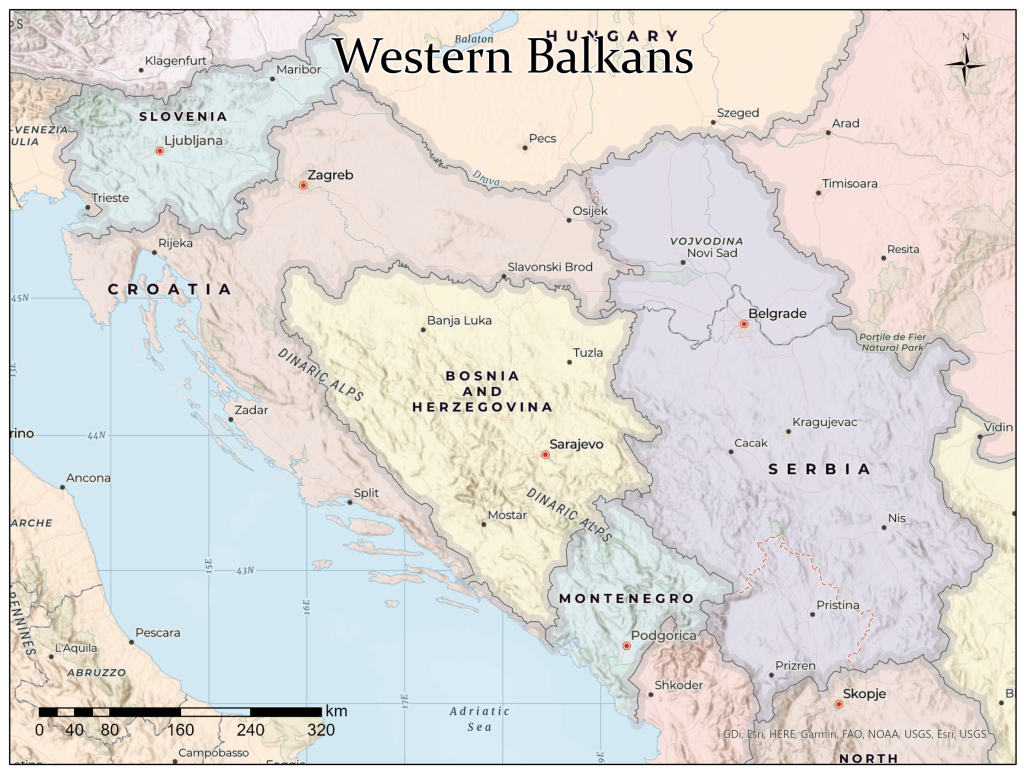
2. History
The Balkans have been a place of conflict since ancient times. The modern countries we saw above in section 1 are all relatively recent political constructs. What we find in the region are successive waves of immigration, conquest, and assimilation. We don’t really know much about the original inhabitants of the northern part of the region. It may have been in habited by a Celtic-speaking people. But the dominant cultures of around 1CE were the Romans, Persians, and Greeks. The Romans conquered most of the region and incorporated it into their Empire. The peoples of Romania and Moldova, and scattered communities throughout the region (known as Vlachs and Aromânians), still speak languages descended from Latin. After the split of the Roman empire into the western and eastern (Byzantine) empires, Slavic-speaking people moved to the area from the Ukrainian steps. Descendants of those Slavic-speakers are now found throughout Bulgaria, North Macedonia, Serbia, Bosnia-Herzegovina, Montenegro, Croatia and Serbia (Carter 1977, Dvornik 1962).
By the beginning of the 19th century, the bulk of the Balkans was divided between two great empires: The Austrian Empire (which later became the Austro-Hungarian Empire) and the Ottoman Empire. The Austrian Empire brought the Catholic religion and many western aesthetics in music and dance to the regions they controlled. The Ottomans came to Europe from Turkey in the 14th century and conquered about ½ of the region we now call the Balkans. They brought with them the Islamic religion as well as eastern tastes in music and dance. The countries of Bosnia, Albania, Macedonia, Bulgaria, Serbia, Romania, Turkey, and Greece were all at some point part of the Ottoman empire, although various independent states popped up through the years. While the Ottoman empire brought with it middle eastern religion and culture, it was also a pluralistic, multilingual, multi-religious empire.
The first world war started in Sarajevo, now the capital of Bosnia, with the assassination of the Archduke Ferdinand. After 30 years of tumult through the two world wars, what emerged was at the heart of the Cold War. Romania, Albania, and Bulgaria formed their own countries. Slovenia, Serbia, Bosnia, Croatia, Montenegro, and Macedonia were unified into a communist country known as Yugoslavia. By contrast, nearby Greece and Turkey were aligned with the west.
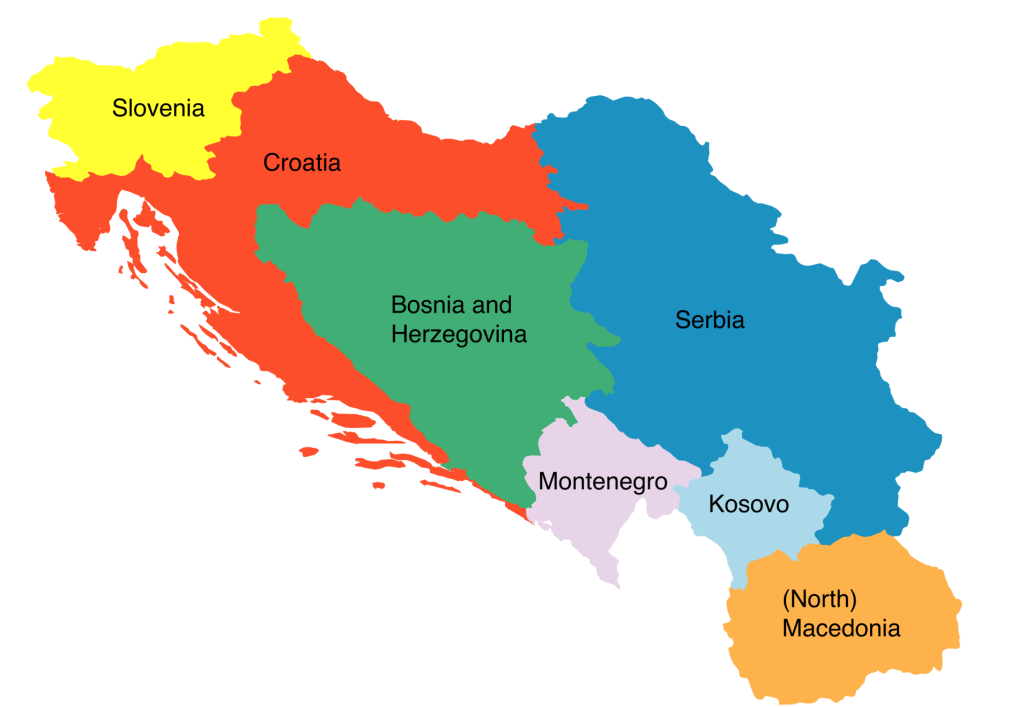
In the late 1980s and early 1990s, with the collapse of the Soviet Union and the Warsaw pact, we also saw the collapse of the communist regimes in the Balkans. In Yugoslavia, what followed were racially fueled wars that dissolved the country into several independent states. Particularly tragic was the Bosnian/Croatian/Serbian conflict of the 1990s. It was a horrifying war that saw genocide, rape, concentration camps, and remarkable brutality. The combatants were divided primarily along religious lines, with the Catholic Croats, the Orthodox Serbs and the Muslim Bosnians all taking uncompromising positions. The result of this war was a situation where multi-ethnic and multi-religious villages and cities underwent what came to be euphemistically called “ethnic cleansing”. Neighbors turned against neighbors and the countries of the former Yugoslavia came to be less integrated, and more divided upon ethnic lines. The tragedy was repeated again during the Kosovo conflict at the end of the 1990s. Kosovo was traditionally part of Serbia, but a high proportion of the population is actually Albanian in language and culture. These two communities fought another war, and now the nation is highly divided between Serbian and Albanian communities. There is a tenuous peace throughout the region now, but old ethnic hatreds and grudges are still evident. To the outsider this is baffling, because as we will see below the dances and music from these regions have much in common culturally.
3. A Complicated Patchwork of Culture
We now turn to some of the cultural characteristics of the countries in the west of the Balkans. What we find is that the cultural markers of each country blend in a complicated way with those of their neighbors.
3.1. Language
Most of the languages spoken in the western Balkans are closely related members of the Slavic Language group. Although there are important dialect differences, people can largely understand the language of the communities near them. This is much like how American English speakers can understand British English speakers. Slovenian[1](Slovenščina) is spoken in the far west. It is perhaps the most different from the other dialects and has lots of commonalities with Slovak and Czech. Slovenian is written in the Latin Alphabet. Serbo-Croatian-Bosnian (Srpskohrvatsko, Српскохрватски) is the language spoken in Serbia, Croatia, Bosnia-Herzegovina, and Montenegro. It has a variety of dialects, but all are mutually intelligible, at least between the dialects of close neighbors. The Croatian and Bosnian forms are written in the Latin Alphabet. The Serbian and Montenegrin forms are written in the Cyrillic alphabet. There are also a number of minority languages spoken in these areas. Hungarian is spoken by people in northern Croatia. Romani is spoken by the Roma (formerly pejoratively known as “gypsies”), Macedonian is spoken in South Serbia, the Vlach language is spoken by the Vlach minority and Albanian is widely spoken throughout in Kosovo.
3.2. Religion
The three major religions in the former Yugoslavia are Catholicism, Eastern Orthodoxy, and Islam. There are of course communities of each of these in each of the countries but after the wars of the 1990s, there is a much more homogenous pattern. Slovenia and Croatia are majority Catholic. Bosnia-Herzegovina and Kosovo are majority Muslim. Serbia and Montenegro are majority Eastern Orthodox.
3.3. Traditional Costumes
Slovenian folk costumes are similar to those of Hungary, Italy, and Slovakia. The men wear white shirts, black or brown pants (sometimes made of leather), vests and black hats. The women wear white blouses, and either black or white skirts. They often wear a large floral scarf on their backs.
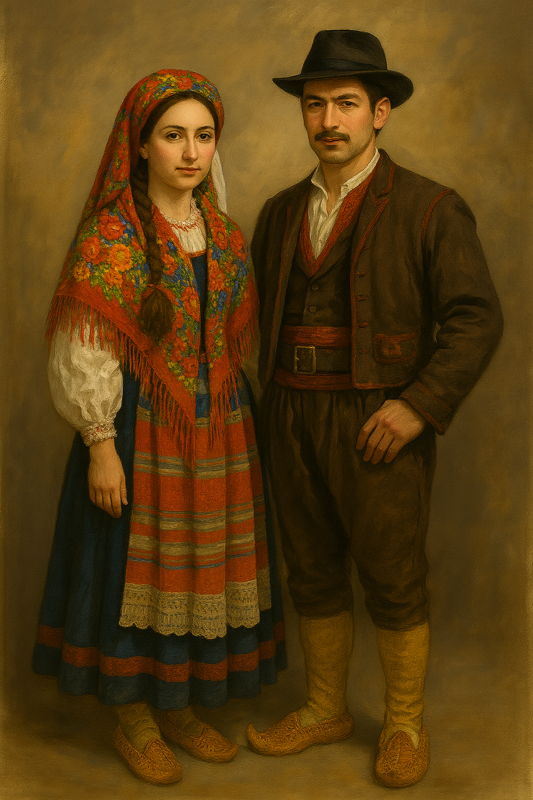
Croatian costumes largely consist of white skirts and blouses for women and white shirts and white pants for men. The shirts and blouses are often highly embroidered as are the aprons of the women. The dance footwear is woven leather shoes, with rounded toes, called opanci.
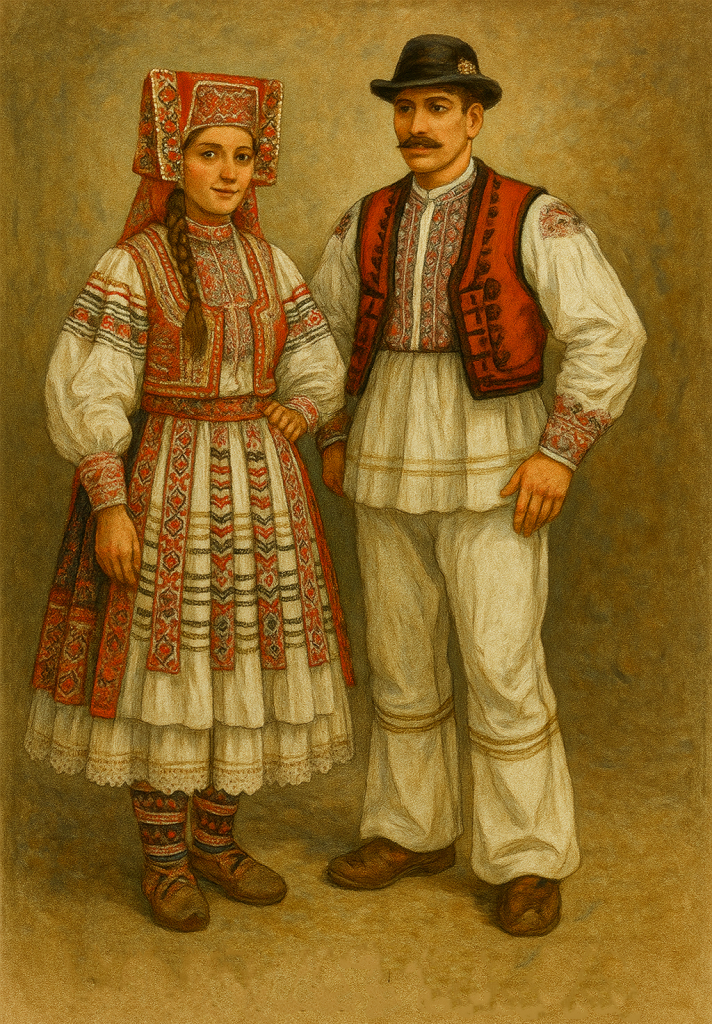
Serbian costumes tend to look more Middle Eastern. The men’s pants are often baggy, like Turkish şalvari. Women wear thick black skirts and heavily embroidered woolen vests. Both men and women wear wide cloth belts. Particularly distinctive about the Serbian costume are the up-turned hooked toes of the opanci.
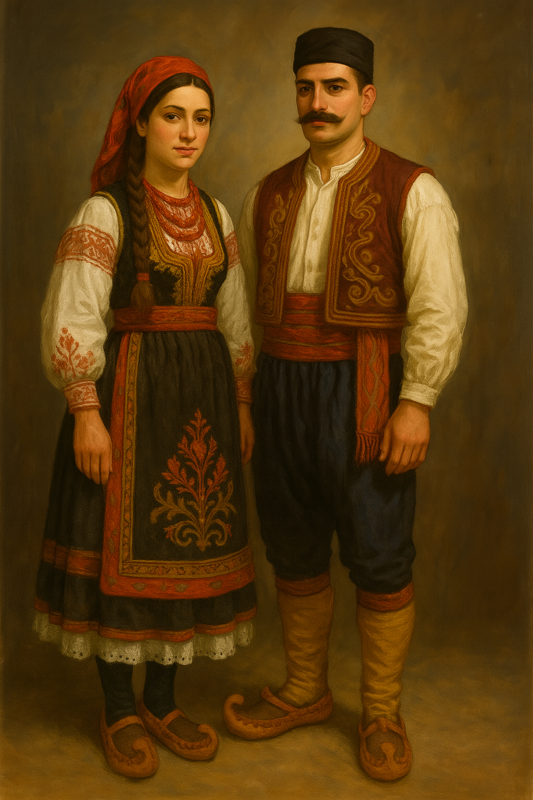
Bosnian costumes look even more Turkish. Men sometimes wear Fez hats, and women will wear headdresses with scarves that cover their hair. Women wear “harem” pants rather than skirts. Prior to the Balkan wars of the 1990s, Bosnia was a much more pluralistic place, and we saw a wider variety of folk costumes. The emergence of these much more Turkish-style costumes as the norm is a relatively recent phenomenon.
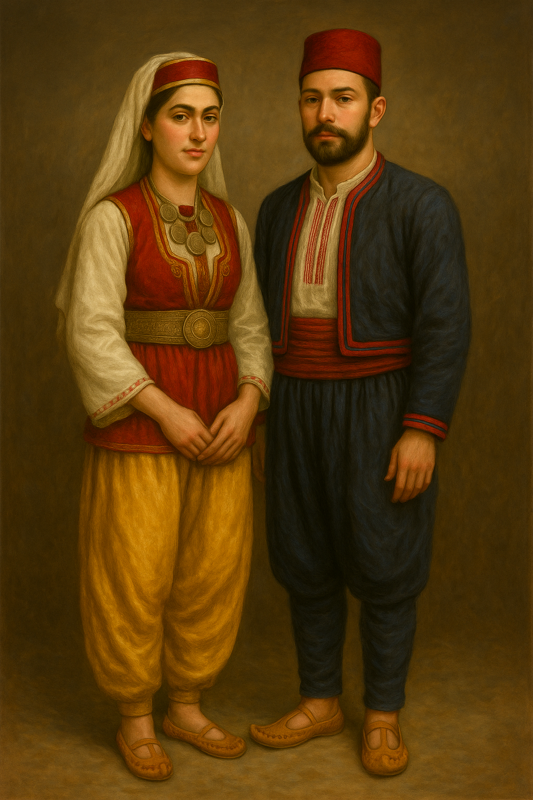
3.4. Music
Each area also has its own musical style. Slovenia is geographically quite close to Germany and its music is very similar to the music of Germany with lots of polkas (2/4) and waltzes (3/4). The instrumentation tends to be accordion bands, clarinets, and brass bands. Croatia is famous for its tamburitza music. This music is characterized by strummed instruments including various sizes of the tambura– a long necked mandolin like instrument. The meters tend to even 2/4, 4/4 and 3/4 meters.


Although the Serbians also use the tambura, their music sounds quite different from the Croatians’, even when they play the same melodies. Instrumentation from Serbia includes more accordion, and frequently highlights a high-pitched flute called the frula. Serbians are also more likely to use some unusual rhythms, like the devetorka rhythm in 9/8 (counted as 4 uneven beats (12)(34)(56)(789) or quick-quick-quick-slow.

The Roma in Serbia and Macedonia use an entirely different palette of Instruments. Emphasizing brass instruments like the trumpet and clarinets, Roma music is often known as “Wedding Music” because it is played at wedding parties of all ethnicities.
Music in Bosnia is similar to that of Croatia and Serbia, but they are much more likely to use musical motifs that are very unfamiliar to western ears. They often use minor keys. When you listen to the YouTube videos linked below you might even think they are “out of tune”. But in fact, they are just playing in an ancient musical “mode” that deliberately makes use of disharmonies to create multiple layers of frequencies. It is a bit of an acquired taste, but once you learn to understand it, it grates less on your ears. Give it a fair chance before you switch it off.

- Slovenian Polka Music: https://youtu.be/jEmf39QaO4I
- Slovenian Polka Music: https://youtu.be/zbfAS-86BcA
- Croatian Music: https://youtu.be/5rr_Ghg6ULY
- Croatian Music: https://youtu.be/VCgsLg-A6N8
- Serbian music: https://youtu.be/8ipUum5S1Ug
- Frula music: https://youtu.be/m2kbvxqTx78
- Bosnian disharmonic music: https://youtu.be/ymRX1rXvZuE
- Bosnian disharmonic music: https://youtu.be/tLviUpTxMNM
- Roma Wedding music: https://youtu.be/CzemR8McjtY (This music is a Čoček – see the chapter on Turkey to learn about the Köçekler)
- Roma Wedding Music: https://youtu.be/viDxwxWpOlQ (this recording is in the 9/8 meter mentioned above)
4. The Dance Cultures of the Western Balkans
4.1. The Dances of Slovenia
The Slovenians have borrowed much from their Austrian neighbors. Slovenia is right next to the Tyrolian valley. They dance lots of polkas and waltzes, which are more typical of central Europe. In the videos linked below you’ll see them dancing the Štajeriš, which is closely related to the Steirer and Laendler dances of Austria and Bavaria. The dances are mostly couple dances and involve intricate patterns where the partners twist their arms into knots.
One other tradition in Slovenian dances include the dances that come from the Rezijan valley, which show patterns more similar to the dances of Northern Italy (also nearby). These dances involve spinning and flirting, but no touching! They probably represent a much older tradition of court dances, related to the bourées and court dances of France.
- Štajeriš: https://youtu.be/vBg9zoDRjho
- Polka: https://youtu.be/jMdhmu6Jatk
- Rezijankas: https://youtu.be/hFzHXw_VhYQ
4.2. The Dances of Croatia
The dances of Croatia are quite different from those of their Slovenian neighbors. They are mostly done in closed circles. Like dances from most Catholic countries the circles tend to progress primarily in a clockwise direction (in contrast to the Orthodox Serbs, whose dances progress in a counterclockwise direction).
One particularly unique property of Croatian dances is the use of Drmeš or shaking steps. You can spot a Croatian dance a mile away if the dancers are shaking or bouncing. The drmeš step is often alternated with fast moving circles. Dances that are done in circles like this are called Kolos. The dancers often hold each other in what is known as a basket hold, where you hold hands with your neighbor’s neighbor, rather than with your immediate neighbor. Typical steps in Croatian dancing include, step-hop-steps, hop-step-steps, rida (down up) steps, and walking steps and of course the drmeš.
- Croatian Kolo: https://youtu.be/Ra-2aVhE-XE
4.3. The Dances of Serbia and Montenegro
Serbia and Montenegro have very similar dance traditions, so we’ll treat them as a unit here. Like Croatia, the primary dances in Serbia are kolos. The main difference being that the circles primarily move counterclockwise or are symmetrical in direction as is common in Orthodox countries. The basic village dance done throughout Serbia is called U Šest. It is so common that people often just call it Kolo. It is a symmetrical dance that goes both to the right and left. Another common the fast moving Čačak which doesn’t fit the phrasing of the music.
In the middle of the 19th century, the rich gathered for social events in ballrooms in major cities like Belgrade. In addition to western polkas and waltzes, they added their own Serbian ballroom dances, which like the kolos, were done either in closed or open circles. An example of this is Jeftanovićevo Kolo.
It’s worth noting that the dances done in South Serbia and in the former Serbian region of Kosovo (now widely recognized as an independent country) are quite different from northern Serbia. South Serbian dances have much more in common with Macedonian dances, for example the dance Devetorka is found in both South Serbia and Macedonia. The dances of the Albanians who live in Kosovo will be discussed in the unit on Greek and Albanian dancing.
- U Šest (Kolo): https://youtu.be/DcYnwb-hAK0
- Čačak: https://youtu.be/t6WlwfIbYdQ
- Jeftanovićevo Kolo: https://youtu.be/t3EVOdJV9wE
- Devetorka: https://youtu.be/QJkyAQgSAaE
4.4. The Dances of Bosnia-Herzegovina
Bosnia lies surrounded by Croatia and Serbia. So, it’s no surprise that its dances are a mélange of the two styles. For the most part Bosnian dances travel counterclockwise like Serbian dances. But one finds dances that feel more like Croatian dances and dances that feel more like Serbian dances.
- A medley of Bosnian dances: https://youtu.be/n1JEWAvM5Xc
Further Reading
- Casey (1981), Carter (1977), Dunin (1984), Dvornik (1962), Finlan (2004). Center for teaching of Folk Dancing (2006), Holden et al (1982), Jankovic and Jankovic (1962), Jelavich (1983), Jergan (2004). Lawson (1995), Roncevic (1975). See the references section at the end of this book for complete citations.
- https://en.wikipedia.org/wiki/Balkans
- https://en.wikipedia.org/wiki/Yugoslav_Wars
Some Suggested dances For Teaching
Slovenia:
- Rezijankas: http://folkdancemusings.blogspot.com/2008/02/rezijankas-1-2-italyslovenia.html
- Stari Sotis: http://folkdancemusings.blogspot.com/2016/09/stari-sotis-slovenia.html
Croatia
- Kalendara Kolo: http://folkdancemusings.blogspot.com/2014/06/kolo-kalendara-croatia.html
- Moja Diridike: http://folkdancemusings.blogspot.com/2014/07/moja-diridike-croatia.html
Serbia
- Savila Se Bela Loza: http://folkdancemusings.blogspot.com/2014/04/savila-se-bela-loza-serbia.html
- Šetnja: http://folkdancemusings.blogspot.com/2014/03/setnja-serbia.html
- U Šest: http://folkdancemusings.blogspot.com/2014/03/kolo-u-sest-moravac-uzicko-kolo-serbia.html
Discussion Question
Discussion Question 1
Often the exact same dances are done by Serbians and Croatians, except the Croatians, being Catholic, primarily rotate the dances clockwise whereas the Eastern Orthodox Serbians rotate them counterclockwise. The historical reasons for this split in direction based on Religion are lost to time, but it’s interesting that this distinction is maintained to this day. Speculate on the reasons why modern Serbians and Croatians might continue or even reinforce this difference?
Media Attributions
- Figure 11.1: Map of the Western Balkans © John W. W. Powell. Additional geospatial data cited in map. Used here with permission.
- Figure 11.2: The component parts of the former Yugoslavia. © Andrew Carnie, made with Mapchart.net
- Figure 11.3: Slovenian Costume © Saman Meihami, assisted by ChatGPT. Used with permission
- Figure 11.4: Croatian Costumes © Saman Meihami, using chatGPT
- Figure 11.5: Serbian Costumes © Saman Meihami, Assisted by ChatGPT. Used with permission
- Figure 11.6: Bosnian Costumes © Saman Meihami, assisted by chatGPT. Used with permission
- Figure 11.7: Brač tambura, Croatia © Musical Instrument Museum, Phoenix. Used with permission
- Figure 11.8: Prim tamburica, Croatia © Musical Instrument Museum, Phoenix. Used with permission
- Figure 11.9: Frula © Musical Instrument Museum, Phoenix. Used with permission
- Figure 11.10: Šargija, Bosnia © Musical Instrument Museum, Phoenix. Used wiht permission

